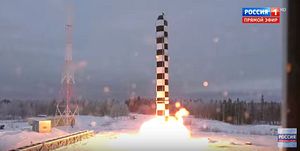I missed out on yesterday’s missile-heavy news cycle after Russian President Vladimir Putin announced of five new strategic systems during a state of the union address. Each system was designed to strike targets in the United States and add to Russia’s strategic deterrent capabilities.
Incidentally, I missed out because I was traveling to speak in Washington, D.C., on the Trump administration’s Nuclear Posture Review (NPR) and regional threats in Asia. (You can watch my panel’s discussion here.) My colleague Franz reported on two of the systems, including the Sarmat intercontinental-range ballistic missile (ICBM) and a new, unnamed, nuclear-powered (yep, that’s right—nuclear powered) intercontinental cruise missile (ICCM).
Our discussion on the 2018 U.S. NPR in Washington was naturally disproportionately focused on Russia given Putin’s announcements. Each of the five systems demonstrates a form of Russian innovation, presumably spurred by concerns over expanding U.S. missile defense capabilities.
Some of this innovation also comes in the form of resurrecting old U.S. Cold War-era concepts, like the nuclear-powered cruise missile with intercontinental range. The United States tried that with the so-called Super Low-Altitude Missile, an intercontinental-range cruise missile that was a practical nightmare given that it contained an unshielded nuclear reactor.
Beyond the Sarmat and the new cruise missile, we saw three other systems. Of those three, we knew about the Status-6 nuclear-powered, thermonuclear payload-bearing autonomous underwater vehicle (AUV), because the Trump NPR mentioned it.
The two other systems were the Avangard, a maneuvering hypersonic payload for the Sarmat, to allow it to penetrate U.S. terminal and midcourse missile defenses, and the Kinzhal, an air-launched hypersonic missile, that may be an air-launched ballistic missile (ALBM) derived from the Iskander family. (There was also a new laser weapon showed off.)
Putin’s reasons for unveiling these missiles when he did merit consideration. My co-panelist yesterday, Kori Schake, made the observation that these announcements are coming in the run-up to the Russian presidential elections. Putin wants to demonstrate strength and an ability to “make Russia great again,” so to speak; showing off a bunch of new and fancy nukes accomplishes that.
I think there’s something to that explanation, but we shouldn’t write off long-running Russian concerns about strategic stability (and by long-running I mean since the United States’ unilateral withdrawal from the Anti-Ballistic Missile Treaty in 2002). Clearly these systems weren’t also built overnight as a response to the Trump NPR or even the western sanctions that were put in place after Russia’s invasion of Crimea and campaign in Donbass.
Russia (and China for that matter) have long-standing concerns that the U.S. insistence that its homeland missile defense systems (the Ground-based Midcourse Defense system) is designed for “limited” threats only and fear a degradation of their strategic deterrents. Russian investment in these new systems—some likely conceived of post-2002 and others older—could well be a testament to that insecurity.
What’s concerning too is that amid U.S. apoplexy about Russian violations of existing arms control treaties (INF, Open Skies, and CFE, for starters) and continued Russian concerns about U.S. missile defense intentions, both sides have just decided to postpone a scheduled bilateral strategic stability dialogue.
This raises the question of how the two countries will address this widening trust gap. If the Trump administration comes around on extending New START, too, many of these systems—as new types of “strategic offensive arms” presumably under the Treaty’s ambit—would have to be addressed.
My sense on Thursday, during the event on the NPR in Washington, was that Putin’s announcement certainly didn’t fly under the radar. That’s positive, but it’s far from clear that this U.S. administration will find a solution for these new Russian systems in arms control.
If one concedes that Russian concerns about U.S. missile defense are genuine, then the prospective path forward is for Washington to agree to limitations on national missile defense—a political nonstarter with the North Korea threat being what it is today (never mind that the systems aren’t nearly as effective as Russia and China might think they are).
If reductions and limitations aren’t possible, then I’m afraid the administration either will work to do everything possible to reduce the perception that the United States accepts vulnerability to Russian nuclear forces. That’ll only harden Putin’s resolve to accelerate the deployment of these new and exotic nuclear delivery methods.

































